JSP学习笔记七之Cookie
Posted 追风少年lulei
tags:
篇首语:本文由小常识网(cha138.com)小编为大家整理,主要介绍了JSP学习笔记七之Cookie相关的知识,希望对你有一定的参考价值。
首先提一下http协议的无状态性,指的是服务器不会记住已经给它发过请求的客户端。每次收到请求都会认为是一个新的客户端发过来的。(即:服务器不会记住给他发过请求的客户端)。
所以这个时候我们就需要使用Cookie来保存用户的状态。
Cookie指web服务器保存在客户端的一系列文本信息。比如:判定注册用户是否已经登陆网站、网购购物车的处理等。所以消耗的是客户端的存储空间。
Session是通过服务器来保持状态的,是服务器端为客户端所开辟的存储空间。所以消耗的是服务器端的存储空间。
1、保存用户的状态的两大机制:cookie和session。
a 、cookie作用:
1.对特定对象的追踪
2.保存用户网页浏览记录与习惯
3.简化登录
不足的是安全风险:容易泄露用户信息
b、session的作用
在创建了Session的同时,服务器会为该Session生成唯一的Session id,而这个Session id在随后的请求中会被用来重新获得已经创建的Session;在Session被创建之后,就可以调用Session相关的方法往Session中增加内容了,而这些内容只会保存在服务器中,发到客户端的只有Session id;当客户端再次发送请求的时候,会将这个Session id带上,服务器接受到请求之后就会依据Session id找到相应的Session,从而再次使用之。正是这样一个过程,用户的状态也就得以保持了。
2、Cookie的常用的方法
创建Cookie对象: Cookie newCookie = new Cookie(String key,Object value);
写入cookie对象: response.addCookie(newCookie);
读取Cookie对象: Cookie[] cookies = request.getCookies();
设置Cookie对象的有效期(秒): setMaxAge()
创建Cookie后进行赋值: setValue(String value)
获取Cookie的名称: getName()
获取Cookie的值: getValue()
获取Cookie的有效期(秒): getMaxAge()
3、下面给出一个Cookie的JSP实例。

login.jsp中使用一个checkbox来进行记录是否记住登陆状态。然后在dologin.jsp进行创建cookie,并且设置cookie的值和向服务器添加cookie实例、设置cookie对象的存活时间等。
在dologin.jsp中会有超链接的存在,用于连接users.jsp。在users.jsp界面会显示刚刚在登陆界面输入的用户名和密码。这里通过checkbox是否被勾选来判断是否需要创建Cookie。程序的逻辑是checkbox的被选上就创建Cookie。
首先是登陆界面login.jsp:
<%
//获取Cookie实例对象中的元素值
Cookie[] cookie=request.getCookies();
String username="";
String password="";
if(cookie!=null && cookie.length>0){
for(Cookie c:cookie){
if(c.getName().equals("username")){
username=c.getValue();
}
if(c.getName().equals("password")){
password=c.getValue();
}
}
}
%>
<body>
<h1>用户登录</h1>
<hr>
<form name="loginForm" action="dologin.jsp" method="post">
<table>
<tr>
<td>用户名:</td>
<td><input type="text" name="username" value="<%=username %>"/></td>
</tr>
<tr>
<td>密码:</td>
<td><input type="password" name="password" value="<%=password %>" /></td>
</tr>
<tr>
<td colspan="2"><input type="checkbox" name="isUseCookie" checked="checked"/>十天内记住我的登录状态</td>
</tr>
<tr>
<td colspan="2" align="center"><input type="submit" value="登录"/><input type="reset" value="取消"/></td>
</tr>
</table>
</form>
</body>
<span style="font-family: Arial, Helvetica, sans-serif;">dologin.jsp代码如下:</span>
<span style="font-family: Arial, Helvetica, sans-serif;"></span><pre name="code" class="html" style="color: rgb(20, 25, 30);"><span style="font-family: Arial, Helvetica, sans-serif;"> <body></span>
<h1>登录成功</h1>
<hr>
<br>
<br>
<br>
<%
//首先判断用户是否记住了登陆状态
String[] isUseCookie = request.getParameterValues("isUseCookie");
if(isUseCookie!=null && isUseCookie.length>0){
//将用户名和密码保存到Cookie中
String username=request.getParameter("username");
String password=request.getParameter("password");
//定义Cookie对象
Cookie usernameCookie=new Cookie("username",username);
Cookie passwordCookie=new Cookie("password",password);
//设置Cookie对象的有效时间
usernameCookie.setMaxAge(864000);//10天
passwordCookie.setMaxAge(864000);//10天
//向服务器中添加Cookie
response.addCookie(usernameCookie);
response.addCookie(passwordCookie);
}
else{
//检查之前是否有cookie存在
Cookie[] cookie=request.getCookies();
if(cookie!=null && cookie.length>0){
//遍历Cookie
for(Cookie c:cookie){
if(c.getName().equals("username")|| //如果出现username和password的Cookie
c.getName().equals("password")){
c.setMaxAge(0);//将该cookie的时间设为0
response.addCookie(c);//重新将Cookie添加到服务器中
}
}
}
}
%>
<a href="users.jsp" target="_blank">查看用户信息</a>
</body>
users.jsp
结果显示:
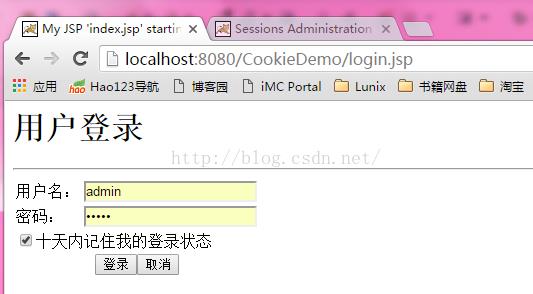

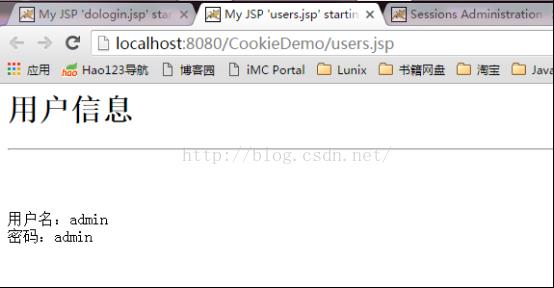
不选择checkbox时的结果:
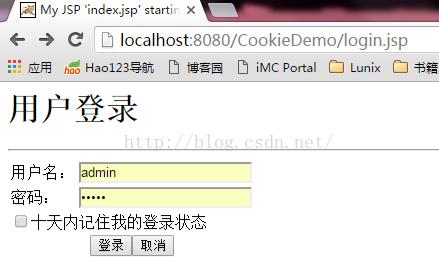
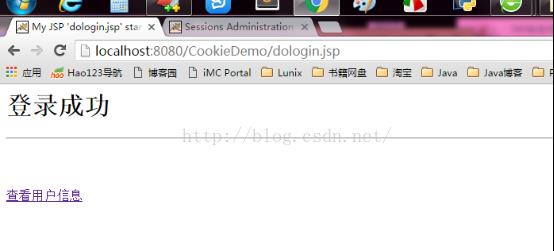
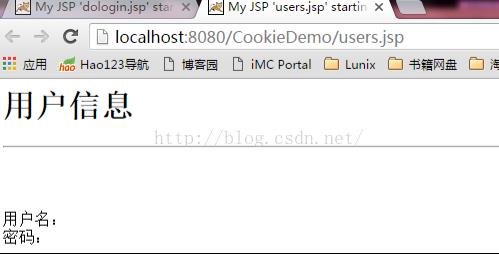
1、JSP常用的有page、include、taglib指令这三种指令
page:位于页面顶端,一个页面可以包含多个page指令。
include:将一个外部文件嵌入jsp中,同时解析这个页面中的jsp语句。
taglib:使用标签库,自定义新的标签,在jsp中启动定制行为。
a、include指令
语法 <% include file="地址"%>。
案例:显示当前时间的页面。步骤如下:
(1)写一个只输出时间的方法的date.jsp。
(2)用于显示的页面,需要包含<% include file="date.jsp"%>这句。
实例代码:
date.jsp
<%
//创建一个日期的实例
Date d=new Date();
SimpleDateFormat sdf=new SimpleDateFormat("yyyy年MM月dd日");
String s=sdf.format(d);
out.println(s);
%>inculde_command.jsp
<body>
<h1>include指令的测试</h1><br>
<%@ include file="date.jsp"%>
</body>结果显示如下:
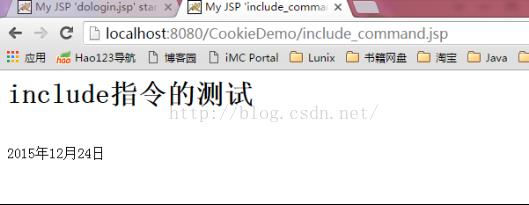
5、include动作(动作标签)
<jsp:include page="URL" flush="true/false" />
page :要包含的页面
flush :被包含的页面是否从缓冲区读取
代码实例:
include_action.jsp
<body>
<h1>include动作的测试</h1><br>
<jsp:include page="date.jsp" flush="false"></jsp:include>
</body>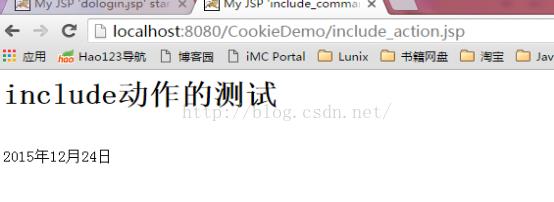
6、include指令和动作的比较:
|
|
include指令 |
jsp:include动作 |
|
语法格式 |
<%@ include file=””%> |
<jsp:include page=””> |
|
发生作用的时间 |
页面转换期间 |
请求期间 |
|
包含的内容 |
文件的实际内容 |
页面的输出 |
|
转换成Servlet |
主页面和包含页面转换成一个Servlet |
主页面和包含转换为独立的Servlet |
|
编译时间 |
较慢-资源必须被解析 |
较快 |
|
执行时间 |
稍快 |
较慢-每次资源必须被解析 |
以上是关于JSP学习笔记七之Cookie的主要内容,如果未能解决你的问题,请参考以下文章